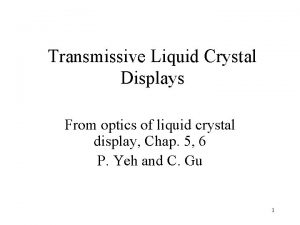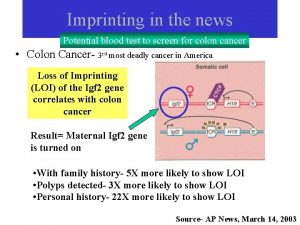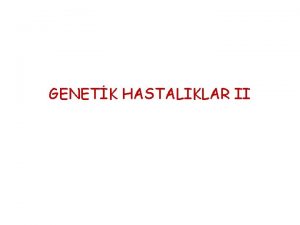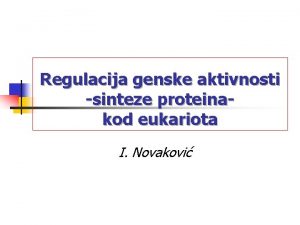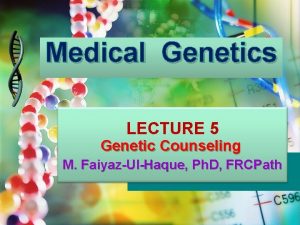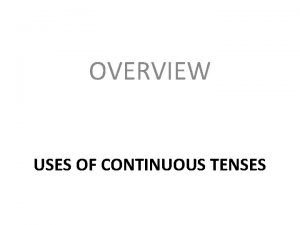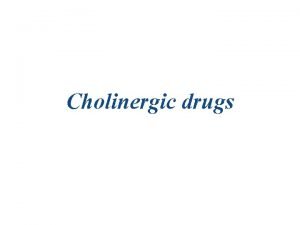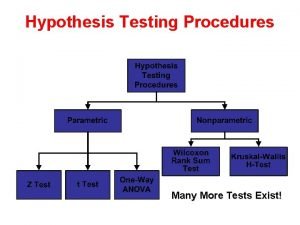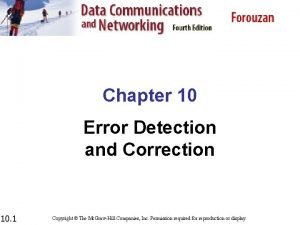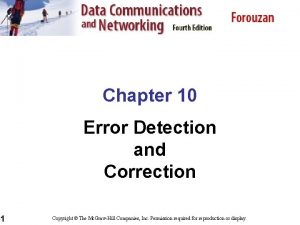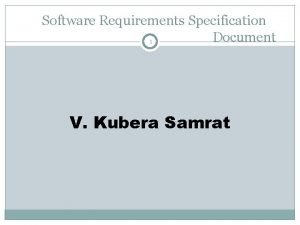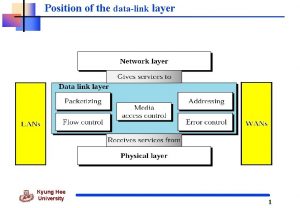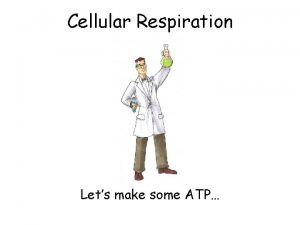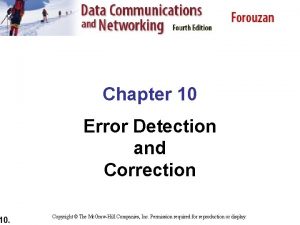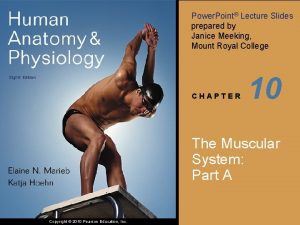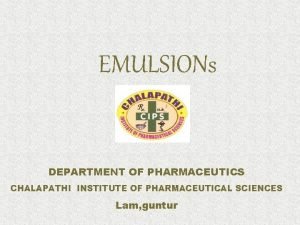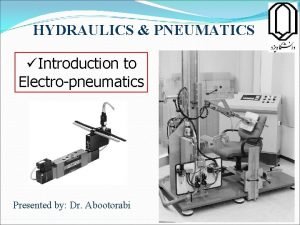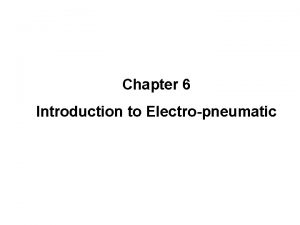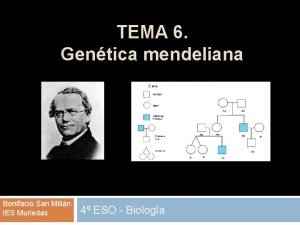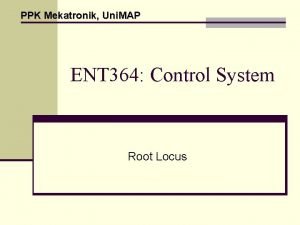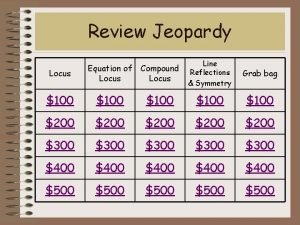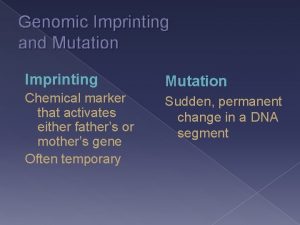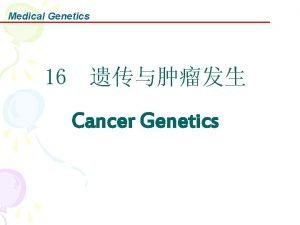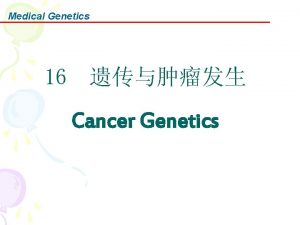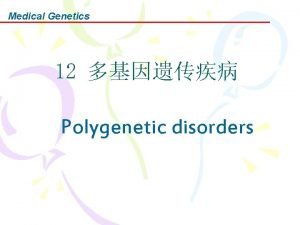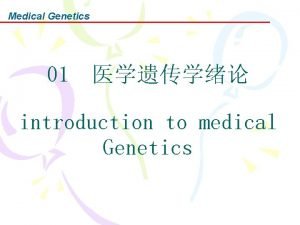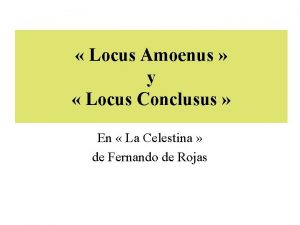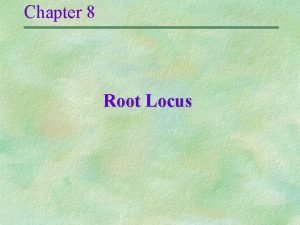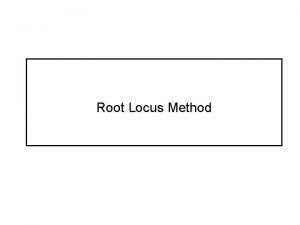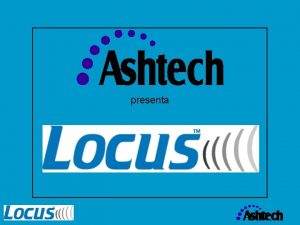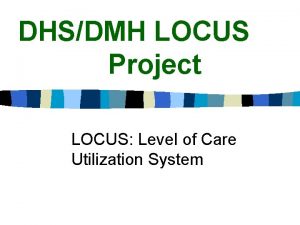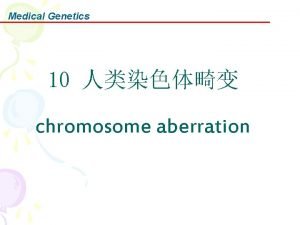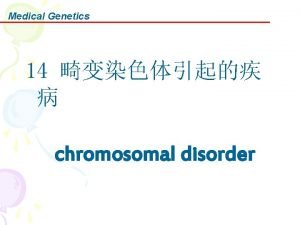MEDICAL GENETICS Imprinting Normally at a given locus


















































- Slides: 50

MEDICAL GENETICS

Imprinting Normally at a given locus we have two alles one from mother and the other from father Definition: At a single locus, only one allele is active, the other is inactive.



Why DNA methylation causes epigentic silencing DNA methylation acts as an epigenetic modification in vertebrate DNA. Recently it has become clear that the DNA and histone lysine methylation systems are highly interrelated and rely mechanistically on each other for normal chromatin function in vivo.

Imprinting Definition: At a single locus, only one allele is active, the other is inactive; Phenotype depends on origin of mutation paternal v. maternal Both syndromes due to inactivation or deletion of genes on chromosome 15 q (11 -13) Can also occur as a result of uniparental disomy Deletion of normal chromosome 15 q(11 -13) from Paternal side: Pader Willi Deletion of normal chromosome 15 q(11 -13) from Maternal side: Angel Man Syndrome

Imprinting Prader-Willi: Deletion of normally active PATERNAL allele Mental retardation Obesity hypogonadism Hypotonia At birth usually demonstrates "floppy baby" with "undescended testicles"

Imprinting Angelman’s syndrome “Happy Puppet Syndrome” : Deletion of normally active MATERNAL allele Mental retardation seizures ataxia innapropriate laughter AS is named after a British pediatrician, Harry Angelman, who first described the syndrome in 1965

Modes of Inheritance Ø Autosomal Dominant: Affects both males and females in all generations. Presents clinically after puberty and FH is essential for diagnosis. Ø Examples: Achondroplasia, Huntington’s dz, Neurofibromatosis types 1 & 2, and many more!

Autosomal Recessive Only offspring of 2 carrier parents can be affected. Usually only seen in one generation, usually due to enzyme deficiencies. Commonly more severe than dominant disorders, presents in childhood Examples: Albinism, Cystic Fibrosis, PKU, Wilson’s dz, and many more!

X-Linked Recessive Only sons of heterozygous mothers can be affected, no father to son transmission. Examples: Fragile X, Lesch-Nyhan, Hemophilia A and B Females may rarely be affected due to random inactivation of X chrom (e. g. Lyonization)

Lyonization X-inactivation (also called lyonization) is a process by which one of the copies of the X chromosome present in female mammals is inactivated. The inactive X chromosome is silenced by its being packaged in such a way that it has a transcriptionally inactive structure called heterochromatin.

X-Linked Disorders X-Linked Recessive Inheritance: X Inactivation or Lyonization: One of 2 copies of X Ch inactivated in female mammals Inactive X Ch silenced packaging into inactive heterochromatin Barr Body in female cell nucleus Reason? So that no duplication of gene products bcz of double X Ch as compared to males (dosage compensation) Inactivation is Random but once inactivated will remain for lifetime Applied to both homozygous and heterozygous recessive females In heterozygotes, it’s almost always the mutant or abnormal allele that is inactivated Remotely possible for normal allele to be deactivated in most cells to express the disease Variable proportion of cells in which mutant X Ch is active

Modes of Inheritance X-linked dominant: Transmitted through both parents, males and females can be affected, but all females of affected fathers are affected. Example○ Hypophosphatemic rickets: increased phosphate wasting at proximal tubule

Modes of Inheritance Mitochondrial: Transmission ONLY through the mother. All offspring of affected mothers are affected. Variable expression due to heteroplasmy

Autosomal Dominant Dz’s Achondroplasia Genetics and Cell Level: ○ Defect in Fibroblast Growth Factor receptor 3 Causes abnormal cartilage development Phenotypic Traits: ○ Dwarfism: short limbs, head and neck normall size Misc info: ○ Associated with advance paternal age ○ AD so if one parent affected then 50% of children affected ○ Homozygotes die either before or shortly after birth

ACHONDROPLASIA (Dwarfism) Defined as a bone growth disorder characterized by abnormal body proportions

Autosomal Dominant Dz’s APKD (adult polycystic kidney dz) Genetics and Cell Level: ○ 90% due to mut in APKD 1 on chromosome 16 Phenotypic Traits: ○ Bilateral enlargement of kidney due to multiple cysts Clinical Presentation: flank pain, hematuria, HTN, progressive renal failure Usually presents in adulthood (hence the name!) Misc info: cysts in the liver ( 30% ) berry aneurysms of the circle of Willis ( 10 -15%) mitral valve prolapse (MVP) Colonic diverticulosis

Autosomal Dominant Dz’s Familial Adenomatous Polyposis Genetics and Cell Level: ○ Deletion on chromosome 5 q 21 -22 (APC gene) Phenotypic Traits: ○ Colon covered with polyps after puberty that progress to 100 % cancer if not resected around 30 years Clinical Presentation: anemia, melena, changes in bowel habits Misc info: (Screening, Definite ? Will need yearly colonoscopies beginning age of 12 ○ Once you see polyps do colectomy ○ Also do upper GI endoscopy to rule out polyps congenital hypertrophy of retinal pigment epithelium

Autosomal Dominant Dz’s Lynch Syndrome (HNPCC or hereditary nonpolyposis colorectal cancer) Other Cancer like endometrial (2 nd most common), ovarian and gastric cancers common Genetics and Cell Level: ○ Due to defects in Mismatch Repair Genes Misc info: Ø Three or more family members with colon cancers, one of whom is a first degree relative of the other two Ø Two successive affected generations Ø Colon cancer in one family member under age 50 years ○ Will need yearly colonoscopies beginning age of 20 to 25 ○ Endometrial sampling beginning at age of 30 ○ Gastric and ovarian cancer screening at age of 30

Autosomal Dominant Dz’s Neurofibromatosis 1 (NF 1/von Recklinghausen’s dz) Genetics and Cell Level: ○ Mutation on chromosome 17 q 11 (long arm of 17) ○ This neurofibronin gene is a negative regulator of Ras oncogene (Increases incidence of cancers like Juvenile myelomonocytic leukemia and Malignant Nerve Sheet Tumor

Neurofibromatosis 1 (NF 1/von Recklinghausen’s dz) Clinical Presentation: café-au-lait spots neural tumors Lisch nodules (pigmented iris hamartomas) Misc info: ○ Increased incidence of Optic Gliomas, pheochromocytomas, susceptibility to tumors, and skeletal disorders

NF 1 Café Au lait spots Lisch Nodule

Autosomal Dominant Dz’s Neurofibromatosis 2 (NF 2) MISME Multiple inherited Schwanomas, Meningeomas and Ependymomas Genetics and Cell Level: ○ Mutation on chromosome 22 q 12 ○ Merlin gene

Autosomal Dominant Dz’s Neurofibromatosis 2 (NF 2) Clinical Presentation: Bilateral acoustic neuromas on CN 8 is the diagnostic ○ Tumors may cause tinnitus, hearing loss, balance problems, vertigo, etc. Juvenile Subscapular Cataract Brain and other crainial nerve tumors: Schwanomas, meningiomas, astrocytomas Spine; astrocytomas and ependymomas. If unilateral acoustic neuroma with meningioma, glioma , schwanoma, Cataract or First degree relative with NF II

NF-2 may be inherited in an autosomal dominant fashion, as well as through random mutation

Autosomal Dominant Dz’s Tuberous Sclerosis Genetics and Cell Level: ○ mutation of either of two genes, TSC 1 and TSC 2 ○ code for the proteins hamartin and tuberin, respectively. ○ These proteins act as tumor growth suppressors, agents that regulate cell proliferation and differentiation ○ causes benign tumors called as HAMARTOMAS to grow in the brain and on other vital organs such as the kidneys, heart, eyes, lungs, and skin.

Most common cause of Morbidity in Tuberous Sclerosis is Seizures Mostly patient present with a type of seizures called as infantile spasm hypsarrythmia can be seen on EEG Rx with ACTH therapy to reduce CRH levels CRH is known to have excitatory physiological actions on neurons and can induce seizures


Autosomal Dominant Dz’s Tuberous Sclerosis

Tuberous Sclerosis: facial angiofibromas in characteristic butterfly pattern Ash Leaf Spot Adenoma Sebaceum

Autosomal Dominant Dz’s Von Hippel-Lindau disease Genetics and Cell Level: ○ Deletion of VHL gene (tumor suppressor) on chromosome 3, results in expression of hypoxia inducible factor 1α (HIF 1α) and activation of angiogenic growth factors Phenotypic Traits: ○ Hemangioblastomas of retina/cerebellum/medulla ○ About ½ of affected develop multiple renal cell carcinomas and other tumors ○ Pheochromocytomas Clinical Presentation: miscellaneous can be discomfort from growing tumors or blindness 2/2 tumors in retina

Autosomal Recessive Dz’s a 1 -antitrypsin deficiency (14 q 32. 1) Genetics and Cell Level: ○ A 1 AT is Serine protease inhibitor produced by the liver and protects the lungs from Neutrophil Elastase

It is a genetically inherited autosomalcodominant condition with more than 120 alleles identified. There are several forms and degrees of deficiency; the form and degree depend on whether the sufferer has one or two copies of a defective allele. In the literature it has been described as either a recessive or codominant trait as there is some evidence that smoking heterozygotes are affected.

Autosomal Recessive Dz’s a 1 -antitrypsin deficiency (14 q 32. 1) Clinical Presentation: Less A 1 AT in blood to neutralize the effect of elastase enzyme secreted by neutrophil. The elastase dissolves alveolar septae resulting in COPD Mutant A 1 AT protein is not secreted into the blood stream. It accumulates in the liver cells , resulting in cirrhosis in early adulthood High risk of hepatocellular carcinoma Misc: ○ Important when presented with pt who has COPD and has only smoked for a few years

Autosomal Recessive Dz’s Cystic Fibrosis: this one is important Genetics and Cell Level: ○ More than 900 genetic mutations in CFTR( cystic fibrosis transmembrane conductance regulator ) gene are known to cause Cystic Fibrosis ○ CFTR gene mutation on chrom 7 DF 508 classically ( the codon for phenylalanine at position 508 ). ○ Defective Cl channel

In Lungs Normal Cystic Fibrosis

In Lungs Normal Cystic Fibrosis

In Lungs Normal Cystic Fibrosis

In Lungs Normal Cystic Fibrosis

In Lungs Normal Cystic Fibrosis

Same thing in Pancreas and Vas Deference Normal Cystic Fibrosis

Autosomal Recessive Dz’s Cystic Fibrosis: this one is important Clinical Presentation: secretion of abnl thick mucus into lungs, pancreas, and liver ○ Pulm infections (P. aeruginosa and S. aureus) ○ Chronic bronchitis, bronchiectasis, pancreatic insufficiency, male infertility (absence of vas deferens)

Gives rise to hypertonic sweat

Autosomal Recessive Dz’s Cystic Fibrosis (cont. ) Diagnosis: ○ increased concentration of Cl in sweat test ( 1 st test to be done ) ○ Genetic Testing is not sensitive (Because till now we have mapped more than 900 mutation in CFTR gene linked to cystic fibrosis and many more may be there which we don’t know) ○ Nasal Potential Test is confirmatory (Confirmatory test )

Symptoms respiratory symptoms are more prominent in adulthood recurrent pulmonary infections ○ Pseudomonal spp and S. aureus are most common chronic sinusitis chronic, productive cough dyspnea on exertion hemoptysis

Symptoms Gastrointestinal symptoms are more prominent in infancy chronic, frequent diarrhea ○ greasy stool with flatulence from malabsorption secondary to pancreatic insufficiency ○ can lead to rectal prolapse meconium ileus( It is extremely sticky and causes the bowel to be blocked at birth) in infants (15%) pancreatitis

Symptoms Other symptoms calcium oxalate kidney stones ○ secondary to fat malabosorption For Patients with Calcium Oxalate Kidney Stones advise decreased Calcium in Diet.

Autosomal Recessive Dz’s Treatment: ○ N-acetylcysteine to loosen mucus plugs ○ Nasal Irrigation of Sinuses ○ Adequate hydration ○ Antibiotics especially against Pseudomonas Aeruginosa (inhaled Tobramycin) and others ○ Pancreatic Enzymes Misc: ○ If presented with. . . THINK CF! newborn with meconium ileus or failure to thrive Fat soluble vitamin deficiency Pancreatic insufficiency

END
 Normally white vs. normally black
Normally white vs. normally black Difference between innate and learned behavior
Difference between innate and learned behavior Imprinting definition psychology
Imprinting definition psychology Genomic imprinting definition
Genomic imprinting definition Imprinting meaning psychology
Imprinting meaning psychology Dengeli kromozom anomalileri
Dengeli kromozom anomalileri Barovo telo
Barovo telo Apgar score
Apgar score Medical genetics lecture
Medical genetics lecture Verbs not normally used in the continuous tense
Verbs not normally used in the continuous tense Difference between muscarinic and nicotinic receptors
Difference between muscarinic and nicotinic receptors Failure to give care that is normally expected
Failure to give care that is normally expected Infomation
Infomation Mann-whitney u test vs t-test
Mann-whitney u test vs t-test The divisor in a cyclic code is normally called the
The divisor in a cyclic code is normally called the The divisor in a cyclic code is normally called the
The divisor in a cyclic code is normally called the Soil bearing capacity
Soil bearing capacity Characteristics of bad srs document
Characteristics of bad srs document Salient features of ellingham diagram
Salient features of ellingham diagram The divisor in a cyclic code is normally called as
The divisor in a cyclic code is normally called as A fish normally displaces its own
A fish normally displaces its own The fermentation of glucose by yeast normally yields *
The fermentation of glucose by yeast normally yields * What do you usually do on weekends?
What do you usually do on weekends? Types of epic poetry
Types of epic poetry Comparison between virtual circuit and datagram network
Comparison between virtual circuit and datagram network The divisor in a cyclic code is normally called as
The divisor in a cyclic code is normally called as The strongest muscle contractions are normally achieved by
The strongest muscle contractions are normally achieved by A switch in a datagram network uses
A switch in a datagram network uses Conceptual physical science 5th edition
Conceptual physical science 5th edition What is the correct sequence in a typical reflex arc
What is the correct sequence in a typical reflex arc The boolean equation ab + ac = a(b+ c) illustrates
The boolean equation ab + ac = a(b+ c) illustrates Posting normally occurs before journalizing
Posting normally occurs before journalizing Timers in plc
Timers in plc Posting normally occurs before journalizing
Posting normally occurs before journalizing Bottle gum method
Bottle gum method Detent switch pneumatic
Detent switch pneumatic A normally aspirated automobile engine loses about
A normally aspirated automobile engine loses about Decrease in owner's equity debit or credit
Decrease in owner's equity debit or credit The divisor in a cyclic code is normally called as
The divisor in a cyclic code is normally called as Drawing debit or credit
Drawing debit or credit Electro pneumatic contactor
Electro pneumatic contactor Warm air aloft is normally associated with
Warm air aloft is normally associated with Hepburn osteometric board
Hepburn osteometric board Doctors license number
Doctors license number Torrance memorial medical center medical records
Torrance memorial medical center medical records Greater baltimore medical center medical records
Greater baltimore medical center medical records Cartersville medical center medical records
Cartersville medical center medical records Fissura palpebra
Fissura palpebra What is engineering curves
What is engineering curves Tipo de herencia
Tipo de herencia Root locus departure angle
Root locus departure angle
